Part 4 is the final part focusing on Kathy’s perspective. She has been writing It’s Summers Time for many years now. It has changed and grown into a chronicle of her life and this one was a special one with the focus on her time here and all of her memories.
It’s Summers Time –
Holidays, Changes And Memories!
As I write this it’s mid-November and it’s one of those incredible weather weeks in Northeast Ohio. It’s 66°F and the sun is shining. It was a beautiful weekend – we actually got some things done outside in anticipation of Winter. And by the end of the week they are predicting snow. So we’ve learned to take advantage of these fleeting days.
It was also Daylight Savings weekend. I know it made sense ‘back in the day’ but now I’m not so sure and not a fan. It was nice that the sun was up when I got up this morning, but it will be almost dark when I go home. I guess there’s always something to complain about.
Things are changing – again – here in Bee Culture land. Can you believe it’s been two years this month since Kim retired as Editor after 33 years. He’s been keeping very busy with writing and podcasts. Hopefully, some of you have been listening to all of that good information. So now our Bee Culture family is going through more changes. Change isn’t always easy, but most of the time it’s necessary.
Here’s a quick summary of what’s been going on and what’s going on for the future. Two years ago Jerry took over as Editor of Bee Culture when Kim was ready to move on. It’s been quite the journey and hopefully most of it has been enjoyable and exciting for Jerry. I’ve certainly enjoyed getting to know him better as a friend and as a boss.
When Jerry walked in the door there was myself, Jean Newcombe and Amanda DeSimone here in the office. We also have Brenda Bray in MN who helps us out with layout and design and who took over BEEKeeping, Your First Three Years quarterly. Although we no longer publish the quarterly Brenda is still a part of our team and helps us out whenever we need her.
In the September issue I talked about Amanda and her moving on after the birth of Liliana. She is doing well and enjoying being a mom. As it turns out her parents are having some health issues and Amanda is concentrating on that. I miss her but we keep in touch on a regular basis.

Amanda, Jean and me at the Tri-County meeting in Wooster, OH in March 2019.
Now I’d like to talk a bit about Jean. Jean has been in my life for almost 30 years. She is one of my treasures. She worked in the Root Company customer service department for several years and was exceptional at it. Customers would specifically request to talk with her. During that time she had her daughter Katie who is I think 26 now. And then some years later along came her son Jake. Jake had a rough start with some health issues and some special needs that needed to be met. To better accommodate Jake’s needs, Jean left the Root Company and took a position with one of the hospitals in the area that offered her more flexibility. But we always remained close friends.
As Bee Culture went through more changes Jean offered to come back part time, while still working at the hospital, and help us out. And she found her spot with selling advertising and has done and is still doing an amazing job at that. She’s established lasting relationships with so many of the industry people. And as Jake got older Jean was able to travel with Kim and I to several of the National meetings. So many of you got to meet her in person. All this time Jean has also kept her full time position at the hospital getting promoted along the way.
Now comes the next change happening to our little Bee Culture family. Some of you know already that I will be retiring as of December 31 of this year. I’ll be around for the January issue and then I’m moving on down the road.
It’s been a journey I could never have planned or dreamed of. I’ve talked about the details over the years on these pages. When Kim got ready to finally talk about retirement we agreed that we shouldn’t both leave at the same time. We thought that would cause too much disruption and our wish was to have a smooth transition and leave things as neat and tidy as we could. At the time two years seemed so far away and yet here it is.
Oh, the places we’ve been and the people we’ve met. Kim and I have been so incredibly blessed by this journey that we have been on for these 30+ years. We have been to bee meetings all across the U.S. and visited several other countries all while talking and teaching and writing about honey bees. The friends we have made along the way are absolutely amazing and will be with us forever, living on in photos and memories even if we don’t physically cross paths again. Along the way we’ve lost good friends and that’s always hard. But the blessing is that we got to have them in our lives for a time.
And the same goes for here at Root. I have friends that I’ve had for the whole time I’ve been here. Friends that watched my children grow up and turn into adults. Friends that prayed with me and cried with me and laughed with me over whatever was going on in each of our lives over the years. Those friends are family and we’ll be together forever.
The transition with Jerry taking over as editor has gone well. He’s done a great job establishing himself in this new role. Have there been bumps? Yes there have, just like with any family when changes occur. But Bee Culture is surviving and will carry on.
I’m excited about the next chapter and a little afraid. Mostly I’m looking forward to doing a better job with all of the things I’ve been neglecting – bees, chickens, garden, family. Folks have asked what will you do when you retire. Believe me I have a great long list of things that I’d like to do and just haven’t had the time. So, God willing I’ll get to do some of them now.
I might volunteer at the library, I might learn sign language or how to play the guitar (I took lessons about 100 years ago). One Winter goal is to read many of the stacks and stacks of books that surround me at home. That is one of my great passions – reading.

I wrote the first of these columns in the January 2012 issue. I certainly never fancied myself a writer and really still don’t – but Kim said you need to do this. So I just started writing about what was going on in our lives. And over these years I’ve enjoyed writing about the chickens, our travels, kids, friends, the bees and whatever else popped into my head. And you have graciously received my contributions with positive comments. Thank you for that.
So what happens at Bee Culture now? Well we want to introduce you to Emma Wadel. Emma graduated from Kent State University in May with a degree in Graphic Design, and joined our Bee Culture family at the beginning of September. For the last two months Emma has been learning all the jobs here in Publications because we are still short handed. Her main job will be the layout and design of these 100 pages each month. But she’s been doing an amazing job with customer service – answering your phone calls and emails and entering and managing the subscriptions. She’s also been updating our web page and working on our Social Media presence. And she did the lion’s share of this December issue. Emma is young and smart and excited about her new position.

Emma getting comfortable in Bee Culture land.
I have a few weeks to try and teach Emma all that I know and along the way give her some history of the A.I. Root Company. Emma doesn’t know anything about bees yet, but neither did I or Jean or Amanda. I think her love of bees will come with time. Who knows, maybe by next Summer we’ll get her in a beesuit and out to the beeyard.
So like Kim when he retired, I won’t be going far – physically or emotionally. We will always have bees for as long as we’re able and hopefully will continue to see many of you along the way. As we head into December I hope your vision of what this holiday season should look like is coming true for you. I fi nd lately that I start so many conversations with “Before Covid we did it this way.” I’m optimistic that this year the holidays will be like they were before and even better. The last two years have been hard for lots of reasons. And many of us have lost family and friends. I hope that your memories of those lost will help you through the season.

At our house we’ll have some with us this year who haven’t been there in awhile and we are excited about that. We have a wonderfully big dining room table and I hope it will be full this year. I hope your’s will be too.
From both Kim and I, we wish you a very Merry Christmas and a Happy New Year. Please keep in touch. My new email address is [email protected].
![]()
]]>
Part 3 is from Jerry Hayes the Editor at Bee Culture. He has been here for two years but has known Kathy for many more than that.
From the Editor –
My life with Honey Bees, Beekeeping and with Beekeepers has been incredible. As I look back and reminisce about all the beekeepers, researchers, inspectors, government, media, NGO’s, Big Ag. leaders and regular people, I have met as I have traveled the world because of honey bees it is incredible! But I already said that – and it is absolutely true. Who gets to do these things because of an amazing insect? Not too many.
In this remarkable journey I have had the once in a lifetime opportunity to be able these last two years to be Editor of Bee Culture magazine. I have written papers, and articles and wrote the Classroom column for decades, and a book but I had never been an editor of anything except my own writing.
I have known Kim Flottum for years and Kathy Summers for years. With Kim, two years ago, in his last days before retirement they wanted to find someone who had years of the smiles and laughs and bumps and bruises one gets after 40 years in the industry. Apparently, that was me. And I said yes because Kim and Kathy had already come up with an excellent plan for Bee Culture to maintain it as “The Magazine of American Beekeeping” for all beekeepers. Kim would stay on and train me for a short period of time then retire, and Kathy would stay on for two more years to add to her 30+ years to do the real training then retire.
Bee Culture had at that time two years ago Kathy, Jean Newcombe and Amanda DeSimone. Kathy did design and layout for Bee Culture’s 100 pages every month. Jean was the advertising expert and Amanda, the daily Catch the Buzz, social media, customer service etc. But this strong, knowledgeable group were a family and shared needs and responsibilities back and forth. Everybody was there to help make Bee Culture the best and help each other make this happen.
This is what I was invited into two years ago. What wonderful people to take on a rookie (an old rookie at that) and with tremendous patience lead and guide me as the new Editor of Bee Culture. And really nobody is the “Editor” at the end of the day because we all talk, share and decide what Bee Culture readers will get the most value from. And this is happening more now as Kathy retires at the end of December. Emma Wadel, has been here for a few weeks and is learning and fine tuning her existing abilities in design and layout but learning the nuances of Bee Culture, the yearly calendar, customer service, Catch the Buzz, social media and much more. Kathy has taken her under her wing and Emma will be great.
For me Kathy’s patience, knowledge, skills, abilities, and genuine friendliness are exhibited in each issue of Bee Culture for the last 30+ years. I have learned so much from her. We will all miss her, but I can truthfully say without even asking her that if we have a question or need more direction she will always be there with a smile for us and you.
Jerry Hayes
]]>Part 2 is from many friends and loved ones of Kathy. Many of these people have known her a longtime. There are people from companies we work with and authors and even the new layout and design person that is learning as many tidbits of Kathy’s knowledge as she can before Kathy heads off on her new journey.
From Friends and Loved Ones –
Dear Kathy,
Sorry to see you go. We will miss you. The fact that you stayed on to help Jerry assume the challenge of becoming editor with the departure of Kim shows a continuing contribution to Bee Culture that we all appreciate. Let’s hope that even in retirement you will frequent the halls of the A.I. Root Company to rally the staff, as they produce one of the oldest, most prestigious bee journals in the nation. Meanwhile enjoy your retirement, which I trust will mean more time for other pursuits, including your beloved chickens.
Malcolm T. Sanford
Kathy,
Thank you for all your contributions at Bee Culture. I am especially appreciative of your help with my articles. I wish you the best in whatever you do, you do excellent work!
David MacFawn
I have had the pleasure to work with Kathy Summers for several decades. Saying hello as we travel to conferences, bee meetings and honey shows worldwide. Working at A.I. Root as Graphic Design Assistant Editor, Vice president of Medina Beekeepers and Vice Chairman of EAS. As an EAS Master Beekeeper and a Lifetime member of EAS, I always appreciated the work that Ms. Summers did. The best part that I enjoyed about Kathy was her smile and her honest desire to help. Last her admiration and affection for her flock of Buff Orpington’s was and is outstanding. Keeping her chickens and fighting the snakes has been part of her journey!
EAS Master Beekeeper
Earl Hoffman
Dear Kathy,
You have been a constant friendly face during the decades that I have been a beekeeper. I remember you at various bee meetings working on something, but providing a cheerful smile and answer regardless of how busy you were. In the last few years, I have had the privilege to know you and Kim better and have realized just how hard you work and your dedication to make BC the best magazine, no matter how challenging it is sometimes, especially with limited staff and recent stresses.
More personally, I am touched by your love of nature, plants and bees and consider you a good friend. Bee Culture continues to be an interesting and fun magazine to read each month and you are a vital part of its creation. We will all miss you!
Barbara Bloetscher
State Apiarist/Entomologist
Ohio Department of Agriculture
Kathy Summers and Kim Flottum have been such long time fixtures at Bee Culture, it is hard to imagine the magazine without them. Behind every great man there is a woman, and in this case Kathy had more staying power than Kim did! I am finding it hard to find the words that express how grateful I am to Kathy for everything she has done to help make Bee Culture what it is today: the most popular beekeeping magazine published in the USA. I am also grateful to Kathy for helping to keep Kim in line for so many years. There is a saying that goes: “Do you want to talk to the man in charge, or the woman who knows what is going on?” I always had a sense that it was Kathy that always knew what was going on. Happy trails Kathy. We will miss you. Bees be with you,
Ross Conrad
Kathy,
It is no surprise to hear of your retirement as it was announced back when Kim retired, that you would stay on for a few more years. However it is surprising that it has come so soon.
You have done a marvelous job at A.I. Root and you will be missed. “They” tell me that the whole key is to stay busy and I don’t mean work on the computer. Get some more chickens and ducks and chase them around the garden.
Jim Thompson
I want to thank Kathy for all her hard work over the 30 years at BC. She’s been very kind to me whenever I needed something for the State Fair and she’s always been very helpful when needed. She must be a Queen to put up with Kim. He taught me how to eat fried bee larvae. I will miss her articles.
Nina Bagley
Kathy this is the end of an era. I so appreciate all you’ve done for Bee Culture, the Root Company and for me as well through the years. You deserve a rich and fulfilling retirement. My wish is that you learn to wind down, relax and most of all enjoy the coming years. Thank you. Thank you Kathy. All the best.
xxxxxx(\
-({{{8- Dewey
xxxxxx(/
Bluntly said, I cannot imagine Bee Culture without Kathy Summers making things happen behind the scenes. When was she not there? She has been making things happen for so long, that I can’t even remember when she began. But all things change, and it is appropriate that Kathy now should take some time to work on other things in her life. However, that does not mean that she will not be missed – greatly. Kathy has always been the “implementer.” She was the one who made things happen. She is the organizer. Professionally, I will miss her presence and competence immensely, but I truly wish her well. Hers was a job beautifully done.
James E. Tew, PhD
Columnist, Bee Culture
“Here, take these gloves,” Kathy Summers said, putting a pair of hand-knit mittens sent by her British friend into my hands. I was going for a bike ride on rail-to-trail segment and the weather had turned cooler than I had prepared for. In our friendship, Kathy’s kindness has always been steady, as this example exemplifies, but there were many more as I was working on my books, I was always needing photos, needing photocopies, and needing items that required time I’m sure she didn’t have. Yet, she never rolled her eyeballs, never sighed under her breath, and never expressed impatience with my requests. For all my idiosyncratic projects, I have always felt that she has been an invisible ally, and I hope she enjoys her well-deserved retirement.
Tammy Horn Potter,
KY State Apiarist KY Department of Agriculture
The Apiary Inspectors of America want to wish you all the best in your next edition and hope it is quite the buzz! We sincerely appreciate all your years of dedication and contributions to the beekeeping industry and we are also very grateful for your invaluable work with making our Apiary Program featured articles a stellar appearance in Bee Culture. Hope you are well my friend,
Kim Skyrm
Kathy Summers has been an excellent format and copy editor at Bee Culture for many years, while also writing whimsical and interesting articles about bees and the hobby farm life. What this misses, though, is her eternally sunny disposition. Whether at meetings or in emails this has made it an absolute joy to work with her on various projects. She really sets the tone for a great magazine team at BC. She has tolerated missteps and a whole lot of tardiness from me without complaint, and helps contributors get their message across. It will be great to see Kathy and Kim at meetings for many years and I am sure they will enjoy even more travels and gardening now that both are ‘actively retired’.
Jay Evans
Behind every great man stands a great woman, as the saying goes. Kathy Summers has been the backbone of Bee Culture for as long as I can remember, which is a very long time. I always copied her in my correspondences with editors Kim Flottum and Jerry Hayes, because I know who really runs the show. I will so miss her gentle reminiscences of backyard chickens and travels with her beloved Kim. I also understand that there comes a time. Godspeed and thank you, Kathy.
Ed Colby
Bottom Board columnist
Kathy:
Want to thank you for your many years of service to the A.I. Root Company, working on my monthly column and for designing and formatting my two books. I always knew that I could count on you in getting the job done. Wishing you the best in your retirement years; you have certainly earned it. With best regards.
Clarence Collison
Best wishes Kathy to you on this chapter in your life journey! You have always been such a strong part at Root in upholding and showcasing our heritage and expertise. Your attention to detail and your diligence in everything you do is impressive – even providing us with feedback on the proper orientation of the honeycomb on our Root logo, or working so hard to assure that your seminars and events happened so well! And you always did this in your quiet, gentle manner. Happy Retirement!
Frank Graziano
Kathy,
I have only known you for a short while but I have loved every minute. I appreciate your patience and kindness through all of my learning and many mistakes; as well as your willingness to let me start to put my own mark on the magazine. I can only hope to make the impact you have on everyone in this special community. Have fun in retirement, you definitely deserve it after all the work you’ve done!
Emma Wadel
Part 1 is from Kim Flottum. He was the longtime editor for Bee Culture. He has served many roles in Kathy’s life. He’s been her boss and co-worker. He currently holds the role of loving husband. But most importantly he has been her friend.
From Kim Flottum –
Kathy Summers started life in a small town on the Texas panhandle. When she was in junior high school she moved with her family to California because her father got a good job in 1966, and she graduated from Mt. Diablo High School in 1972. After graduation she worked for a bit for the city while still living at home.
After a couple of years she married, moved to Medina, her husband’s home town and she worked for the phone company for a bit then a short stay in Houston, Texas, then moved back to Medina, Ohio for a job he had taken. She did a stint at the A.I. Root Company in Medina, working with their Church Sales unit and also worked in a bakery for a while, but children made her pause in the work-a-day world to be a mom. She stayed that way with her two sons for a couple of years.
In 1988, a friend who was working in the Root Company’s main office, and whose son Kathy was babysitting during the day, told her of a job opportunity in the Root Company’s Publications office. Typing. Typing book copy.
It seemed the Editor was interested in pulling together a series of articles that Richard Taylor had published in their magazine over the years and gather them together into a collection to be called The Best Of Bee Talk, Richard’s monthly column in their magazine Gleanings In Bee Culture.
The hours were good for both family and work, and the work was pretty straight forward, and, being an excellent typist she signed on. She shared an office with the lady who was doing layout and design for the magazine at the time so Kathy quickly became acquainted with both her and the Editor of the magazine – that would be me.
After a bit she began to pick up some of the tricks of layout and design by both watching and listening, but didn’t actually do much in that line. Then, her office mate took what was to be a short leave to start her own family, and because Kathy at least knew how to turn the computer on she got a raise, changed chairs and began a career.
She was supposed to return to typing books, but the lady she replaced decided that returning to work wasn’t in the cards, so a temporary position became permanent. At least until the end of December this year, when she will retire.
Her early years as designer were a bit hectic because it was strictly on the job training, and there was always, always that deadline. But she squeezed in a few classes on this or that on occasion, and because she enjoyed the challenge and had to do it every day, she became quite skilled at this new life task.
One of the other tasks she came to really enjoy was helping at the vendor booth when Gleanings In Bee Culture went to beekeeper’s meetings. And Gleanings In Bee Culture went to a lot of meetings. Meeting new beekeepers and chatting with those she met last year, or 10 or 25 years ago is still the best part of her job she will tell you.
I had been on the EAS Board Of Directors for Connecticut for a couple of years when I moved to Ohio, but then Chairman Dewey Caron kept me on as an appointed director in charge of membership. So EAS quickly became a regular tour for the magazine people. Summer conferences lasted nearly a week, what with before and after meetings, and Director’s meetings were always a weekend. In 1995, Jim Tew, the Ohio State Extension Specialist and regular contributing author, and Bee Culture put together an EAS Conference in Wooster, and Kathy played a huge role in planning for that meeting.
And in 1994, because of her continued involvement with the EAS Board and her role with The Ohio State Beekeepers, she was elected President of EAS by the Board of Directors of The Ohio State Beekeepers, which meant she was in charge of next year’s EAS Conference, which, coincidently, was the 50th Anniversary of the EAS organization. So, it had to be special.
About 1998, the EAS Newsletter Editor left the position, and Kathy took on that role which she kept for about 15 years. She also was Editor of the Ohio State Beekeepers Association newsletter for several years during this time.
I had become Chairman of the Board for EAS by then, a role first held by John Root quite a few years before this, so we were able to invite all of the Chairmen over the years, and many of the Presidents, for a gathering like no other for the group. The Conference was held at Kent State University, about a half hour’s drive from our office, and we got to know the route pretty well during that year. Kathy was still Editor, so she and I put together the history of the group from the first thought of forming a group like this, including the first actual Conference and every one since, right up to the anniversary Conference. She got Keith Delaplane to begin the meeting walking up to the stage playing his bagpipes!
Over the years we were able to attend an Apimondia meeting in Canada, followed by another in Ireland, and the last one we went to was in Canada again, all having a huge vendor area that we were a part of. Then we were invited to our first National Honey Show in London, followed by several more over the years, each in a different location in the UK. We’ve made long and lasting friends on those visits, mostly, I’m pretty sure, because of Kathy.
But always there were deadlines. When we first began the magazine usually had only 56 pages, then for a time it moved up to 64 and now it is routinely 100 pages a month. Much of this because of the increase in advertising, driven by the increase in circulation. But we didn’t think she had enough to do, so a few years back we started another magazine, a quarterly called BEEKEEPING: Your First Three Years, aimed exclusively at those folks just starting out. That ran for several years until a distribution issue came up and it was decided to merge that content into what is now just Bee Culture. The Gleanings in was discontinued about 30 years ago.
One task that never went away was dealing with the authors. As we expanded, so did the number of people involved in getting information to us to publish. We love our regular authors, actually we love all of them, but unfortunately they have lives too, and sometimes our deadlines and their events didn’t mesh as well as we would have liked, and the deadline wasn’t about to change. So, some months, right at the very end of time, it was hurry up and go, go, go. Of course, there are those special few who are always early, by a week or two and sometimes a whole month early. They are really easy to like. Nevertheless, either way some of these regular contributors have become very close friends over the years.
For several years we were involved in the Mother Earth News Shows, which took us to some familiar, and some not familiar places over the years. Besides learning more about chickens, Kathy managed to sell books and give away magazines to the hundreds of attendees at these and all of the meetings we went to. She did the work, while I was off trying to be important for somebody.
During the Obama Administration, when there was a bee hive at the White House for the organic garden that had been planted, we visited with the White House beekeeper, Charlie Brandts several times. And wouldn’t you know, Kathy got to work at the table sponsored by the local beekeeper’s club during one of the events out on the lawn. But we got to meet many of the staff (the pastry chef was from Ohio which made interesting conversations), and had special tours of the grounds.
The past couple of years have ended traveling however, and attending meetings pretty much came to a halt. However, when things open up again, Kathy won’t be selling books or giving away magazines any more. Nope, she will be sitting in the audience, listening to whoever is speaking for a change. That will be different.
I have to say, over all these years, Kathy has become a very good beekeeper. I’d like to think it was her teacher, but she is much better than I am. She has a very gentle touch when working a hive, slow, soft and easy. I tend not to be that way because I’m always in a hurry. Not Kathy. And she knows her bee stuff very well, always ready to answer a beekeeper’s question about who, what, how, when, why or why not and what tool to use, problem to look for or piece of equipment to fix. She definitely became an asset for all of the folks in the Publications Department.
We’ve worked together now for 33 years, and, I’d like to think, have pretty much enjoyed every one of them. Her two sons are now grown, both living in Medina again, so that part of her life is settling in just as she hoped it would all those years ago when all she did was type.
It’s been quite a story so far Kath (my shortened name for her), so get ready for your second chapter. I know you can handle anything that comes along. And, by the way, thanks for being you.
]]>By: Darryl Gabritsch
Inspecting a hive is only one part of colony management. If you see an issue while inspecting a hive there are various management techniques to do depending on what you see. This article will be three parts. Part 1 covers the concepts behind a hive inspection. Part 2 covers pre-inspection procedures. Part 3 covers the actual hive inspection procedures.
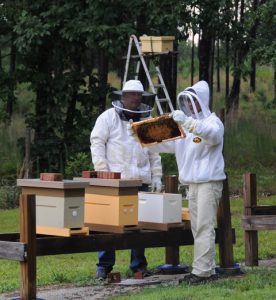 How often and when you inspect a hive totally depends on your lifestyle, beekeeping experience, what your philosophy is and what the purpose of the inspection is. All inspections should be systematic and have a specific purpose. Why are you opening a hive? Are you simply lifting the hive body to check under the frames for swarm cells (cold months)? Are you opening the hive to remove frames to do a detailed inspection (warm months)? Are you opening the top to simply look at the cluster location and strength, or simply checking a hive top feeder?
How often and when you inspect a hive totally depends on your lifestyle, beekeeping experience, what your philosophy is and what the purpose of the inspection is. All inspections should be systematic and have a specific purpose. Why are you opening a hive? Are you simply lifting the hive body to check under the frames for swarm cells (cold months)? Are you opening the hive to remove frames to do a detailed inspection (warm months)? Are you opening the top to simply look at the cluster location and strength, or simply checking a hive top feeder?
Most of us are just hobby beekeepers and have work and home life to balance along with beekeeping. Ask yourself: How much time can I dedicate to beekeeping? What skill level are you at? Are you a beginner beekeeper, a Master Craftsman beekeeper, hobby beekeeper, sideliner beekeeper, or commercial beekeeper? How much time do you have to manage the colonies? Do you mind if the honey bees swarm? Do you simply want to help the honey bees? What is the purpose of the inspection?
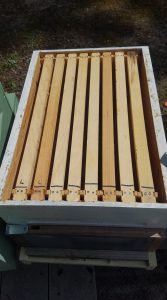
A cold weather hive inspection is very quick compared to a detailed warm weather inspection. In cold temperatures you might only open the top to look down at the frames to see the brood cluster and food stores, or you might tilt the hive body up to quickly check for visible swarm cells without removing frames. Remember the bees will form a cluster in the hive to protect the brood and queen when the temperatures get down to 57 degrees or lower. Don’t be confused if you see individual bees flying in lower temperatures. I have seen them do cleansing flights in temperatures as low as 45 degrees.
In warm weather you can do a detailed inspection by removing frames. As a general rule of thumb, I only open a hive and remove frames if the outside temperature is at least 64 degrees or higher, and if it is not raining to prevent killing brood and bees by hypothermia. I like to remove frames when it is on the cooler side of temperatures if possible and after the foragers leave the hive to forage.
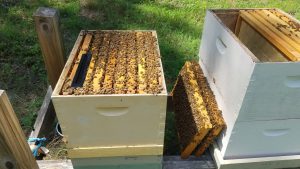 How often you inspect a hive depends on your time available and philosophy. Remember the timeline from a new queen to emerge from an egg to emerging as a queen is 16 days. When you inspect a hive, you disrupt the bees for a few days while they figure out what you did; especially if you don’t put the brood back in the order it was found. To prevent putting the frames back in backwards I simply draw a line across the top on one end of all frames with a black Sharpie pen to help me keep all drawn lines on one end of the hive. Draw the line on the frames before you first put them in a hive since the bees will coat the frame with a thin layer of propolis. The marker won’t easily stay if you try to mark it after the propolis is on the frames.
How often you inspect a hive depends on your time available and philosophy. Remember the timeline from a new queen to emerge from an egg to emerging as a queen is 16 days. When you inspect a hive, you disrupt the bees for a few days while they figure out what you did; especially if you don’t put the brood back in the order it was found. To prevent putting the frames back in backwards I simply draw a line across the top on one end of all frames with a black Sharpie pen to help me keep all drawn lines on one end of the hive. Draw the line on the frames before you first put them in a hive since the bees will coat the frame with a thin layer of propolis. The marker won’t easily stay if you try to mark it after the propolis is on the frames.
We encourage new beekeepers to inspect their colonies at least once every ten days to stay ahead of the swarm cycle and to learn what right looks like inside the hive. I recommend simply inspecting the colony once a week to keep a simple schedule. Ideally you have at least two hives, so you can compare one hive against the other if you see something weird in the hive. You can also take parts from a strong colony to give to a weak colony. Do you have a very weak colony? Give it a frame of brood, nurse bees, and food stores from a strong colony AFTER you first check the frame for the queen. All beekeepers should review reputable beekeeping sites to learn what the various diseases and pests look like, so that you will be able to recognize them when you see them.
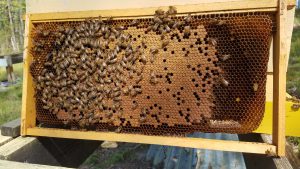 New beekeepers may take 30 minutes or longer to inspect a hive while learning what right looks like inside a colony. A very experienced beekeeper can inspect a colony in about five minutes. Most beekeepers fall between the two extremes. Experienced beekeepers who don’t mind if their colonies swarm might only inspect every few months, or when they see indicators of issues such as pests, disease, very defensive colony, etc.
New beekeepers may take 30 minutes or longer to inspect a hive while learning what right looks like inside a colony. A very experienced beekeeper can inspect a colony in about five minutes. Most beekeepers fall between the two extremes. Experienced beekeepers who don’t mind if their colonies swarm might only inspect every few months, or when they see indicators of issues such as pests, disease, very defensive colony, etc.
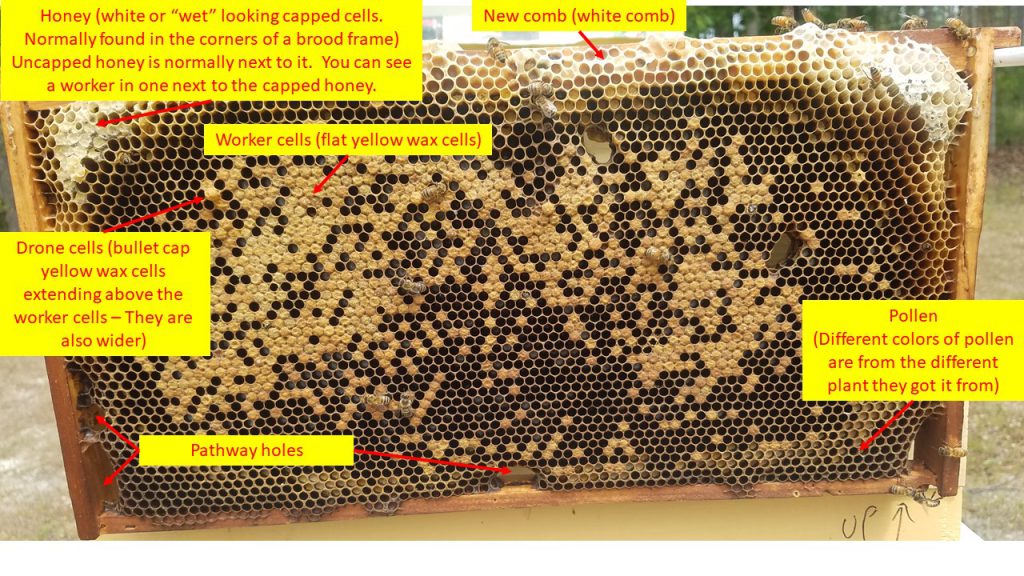 There are many ways to inspect a hive. Remember the adage: Ask 10 beekeepers how to do something and you will get 12 answers; all will be right. This is how I do it: Do all preparations before opening a hive, inspect the hive, take appropriate management steps during or immediately after the inspection, and finally I mark the hive with notes and/or a signal such as a full red brick, half red brick, or stick depending on what I find.
There are many ways to inspect a hive. Remember the adage: Ask 10 beekeepers how to do something and you will get 12 answers; all will be right. This is how I do it: Do all preparations before opening a hive, inspect the hive, take appropriate management steps during or immediately after the inspection, and finally I mark the hive with notes and/or a signal such as a full red brick, half red brick, or stick depending on what I find.
Summary. Learning how to inspect a hive is a crucial step in your beekeeping journey. Having a systematic, purposeful inspection process will keep you focused on the steps needed to conduct a thorough, and eventually a quick, hive inspection. Knowing what to look for will help you determine what is normal and what requires further diagnosis and remedies. Beekeeping is both a science and an art. Beekeeping science is knowing the cause and effect of diseases and pests. Beekeeping art is balancing the various management techniques to keep healthy, strong colonies.
Darryl Gabritsch is a North Carolina Beekeepers Association Master Beekeeper and lives in NC with his family.
]]>By: Jay Evans
This month I was eager to interview my USDA-ARS Beltsville Bee Research Laboratory colleague, Dr. Mohamed Alburaki. Mohamed is the most recent scientist to join our group and he comes with a strong interest in queens, genetics and colony health.
Where are you from originally?
First of all, I want to say thank you, Jay, for this interview and for Bee Culture which does excellent work translating and simplifying honey bee science for all of us.
I am originally from Syria. I was born in Damascus and as my father was planning to pursue his Ph.D. studies on honey bees in France, my family moved to France where I spent most of my childhood.
How did you get interested in honey bees?
As I often say, love for honey bees and beekeeping runs in my family. Some of my earliest memories are of my grandfather’s colonies in his backyard. My grandfather’s passion for bees grew to a more professional level when my father decided to study bee behavior and became a professional beekeeper and scientist, keeping hundreds of colonies in Syria and France. As a child, I was exposed to the fascinating world of bees on a daily basis from a very young age. So, bees become your companion in life, you take care of them and every season they bestow their sweet honey on you. The more you get to know bees, the more questions arise in your head and the result, in my case at least, was that the father’s passion for bees was fully passed to his child. Since I mentioned Syria and France, I would like to share some beekeeping pictures with your readers that I took in these countries during my travels.
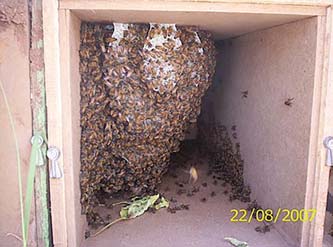
The amazing Syrian honey bee Apis mellifera syriaca in its native environment (Syria). Phenotypically very similar to ligustica but slightly smaller in size and more defensive. Note, ~90% of syriaca bees are hosted in regular 10-frame Langstroth hives.
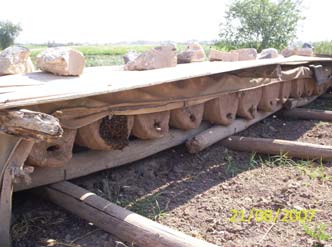
Traditional cylinder hives made of mud still used to host the Syrian honey bee Apis mellifera syriaca in the northern parts of Syria.
Where did you go to school and what did you study?
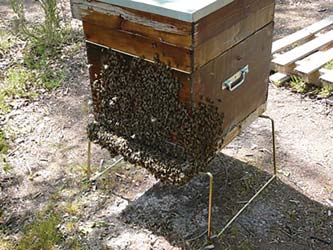
The Black European honey bee Apis mellifera mellifera hosted in a 10-frame Dadant hive, France.
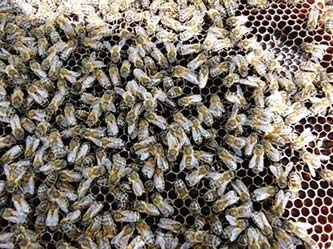
Beautiful Native French queen, drones and workers from the West Mediterranean lineage M, France.
My early desire to pursue studies on honey bees has shaped my entire education choice and career. In order for me to participate in honey bee research (my main objective), I had to first strengthen my knowledge in agricultural science. Coming from a family with an agriculture and farming background, this was kind of a natural choice for me! I obtained my Bachelor’s degree in Agricultural Science from the University of Damascus in Syria. I opted for the Department of Entomology, which would put me right on the doorstep of my main goal, honey bee research. But unfortunately, this was not enough to reach my ultimate goal. Since my deep interest was to explore and link honey bee behavior, phenotype, subspecies and diseases with bee genetic background and diversity, molecular knowledge and skills had to be acquired. Therefore, I pursued an international program led by the European Union and obtained a Master’s Degree in Biotechnology. During my master’s program, I conducted preliminary genetic analysis on honey bees at the CNRS institute in France and subsequently deepened my knowledge with a Ph.D. degree from the University of Pierre et Marie Curie – Paris, France.
What drove you to become a scientist?
The real desire to become a scientist for me was simply to find answers, answers to questions that were often not asked by others or remained unanswered. That being said, my case might be a bit different as my father was a honey bee researcher before me and one cannot minimize a parent’s inspiration on a child.
How did you start your career after school?
Well, the least I can say about my career is that it has been a real international and complex one! After I finished my Ph.D. in France, having already at this point left my birth country (Syria) for a second time and for over six years, I decided to conduct my first postdoctoral research in investigation of the impact of pesticides on honey bee health at Laval University in Quebec, Canada. I continued my research on the same topic during a second postdoc at the University of Tennessee in the USA, followed by a short third postdoc at the University of Southern Mississippi, in which I was looking at honey bee transcriptomic responses to biotic and abiotic stressors. Two years ago, I was fortunate to join the Bee Research Lab in Beltsville (USDA-ARS) as a Research Entomologist, working with a brilliant team of honey bee researchers, all united to find solutions for the betterment of honey bee health and beekeeping.
Where have you travelled in your studies of bees, what was most memorable?
During my exciting bee research and studies, I have been fortunate to travel and reside in many countries. As a Ph.D. student and postdoc, I have attended and presented at many bee conferences such as Apimondia, EurBee, ESA, and at many other local conferences and symposiums in the USA, Canada, France, Syria, Lebanon, Belgium, Ukraine and Turkey.
From a beekeeping stand point, these opportunities are immense! The ability to exchange expertise and discuss face-to-face with peers and colleagues from all over the world is absolutely priceless! I guess the most memorable thing to mention to your readers Jay, is that beekeeping practice and ideology are completely different from one country to another! Particularly, when we talk about countries located in different continents and with significant ecological and environmental variations. We have so far identified approximately 28 different honey bee subspecies! They may share general characteristics, nonetheless, each subspecies has some unique attributes still to be discovered and revealed. To make it short, experiencing first-hand bee local adaptations in their native environments and how the amazing diversity of honey bees is directly translated to behavioral changes, these are definitively the most memorable things in my mind.
What are the biggest challenges facing beekeepers moving forward?
This is a tricky question and the answer might vary slightly from one country to another. As I explained in the previous question, beekeeping practice varies between countries, which means that beekeepers worldwide are destined to face two types of challenges: firstly, universal challenges across the globe, and secondly, local problems related to each country’s conditions and beekeeping practice. Nowadays and due to the astounding and fast development in transportation and communication, the world has become a small village; which means that we need to look at both points I mentioned earlier concurrently. Honey bees have been gifted to all human kind after all, and it is our collective responsibility to take care of them and ensure their continuity and wellbeing. In my opinion, the biggest challenge facing beekeepers in the USA is our capacity to come together with stakeholders, farmers, ecologists and environmentalists and to demonstrate willingness to implement necessary changes and modifications in our beekeeping practices for more sustainable beekeeping and preservation of our ecosystem. Such changes would be guided by collective scientific outcomes and would significantly help to mitigate many of the problems facing the beekeeping industry as a business and the honey bee as an indispensable ecological resource.
What gives you hope? What are the best recent discoveries in bee science?
Hope is always there! We are a nation of great problem solvers, we have been and will always be, this is as long as we stand together and base our decisions on hard core scientific findings. We must lead this effort too, as we do in many other fields. I am hopeful because I know that we have a great number of fine professional and hobbyist beekeepers, queen breeders and producers in this country, as well as bee research laboratories working around the clock to find solutions for beekeeping problems and honey bee health challenges as soon as they appear.
Recently, I have read a few interesting discoveries in the realm of honey bee behavior and pathology that I would like to share with your readers:
How do bees in a swarm locate their queen? In a recently published study, Nguyen et al. were able to show that bees locate their queen by performing a cascade of “scenting” events where individual bees direct their pheromone signal by fanning their wings. During this process, the bees create a dynamic spatiotemporal network that recruits new broadcasting bees over time. The authors used a newly developed high-throughput machine learning tool, allowing them to identify the locations and timings of scenting events [1]. From a pathology stand point, a group of authors from the University of Texas described a promising new molecular method that can suppress deformed wing virus infection in bees and also reduce the rate of varroa mite infestation. The authors engineered a symbiotic bee gut bacterium to produce double-stranded RNA which can induce RNAi immune response in bees and in the parasitic mites as well [2]. This method was used to improve bee survival after a viral challenge. The downside of this method is potential alteration in bee physiology and behavior due to the introduction of dsRNA, which is still to be debated for many years to come. Nevertheless, this tool provides new insights on bee functional genomics which can help to perfect sergical use of RNAi approach for disease control in the near future.
Do you have hobbies and other interests beyond bees and science?
I must admit that most of my time is spent in science and honey bee research including beekeeping. In terms of sports, I have been a professional Karate player and coach for a long time, I like exercising and gardening too. Reading is a natural thing for me, I read books and articles in different languages on a wide range of topics such as religions, history, economy and politics.
]]>By: John Miller
Bee Culture Magazine tasked contributors to interview a person in our industry.
I have long admired Dr. Marla Spivak Ph.D. of the University of Minnesota.
In the early 1990’s Dr. Spivak filled the position formerly held by Dr. Basil Furgala in the Department of Entomology at the UMN Bee Lab. Dr. Spivak poured her considerable energy into the program and the personnel in the program. Dr. Spivak originated the Hygienic bee line. In 2010, Marla was recognized in Entomology by the Macarthur Fellow Program, and in 2016 the new Bee Research facility opened, which allowed her and Professor Dan Cariveau to expand their research and outreach to include native bees and the flowering landscapes that all bees need to thrive.
Dr. Spivak’s work has produced an astonishing number of bee industry scientists and contributors, including Rebecca Masterman, PhD.; Dr. Katie Lee, PhD.; Mike Simone-Finstrom PhD [USDA Baton Rouge]; Mike Gobrilisch, PhD. [USDA-Mississippi]; Judy Wu-Smart PhD. [U. Nebraska]; Autumn Smart, PhD. [U. Nebraska]; Renata Borba, PhD. [Alberta, CA Tech Team]; Jodi Lepsch, Chippewa Valley Technical College [beekeeping]; Hollie Wall Dalenberg, [Masters program]; Marla’s current students are Katie Klett and Maggie Shanahan [both PhD.’s] and The Bee Informed Partnership personnel: Phoebe Koenig, Garrett Slater, Nelson Williams, and Ben Sallmann.
Below, excerpts from our interview:
JM: Lots of people are interested in improved [bee] genetics. I understand you are making another push for an improved line of bees. Can you share some insights?
MS: I am selecting for colonies that survive with no treatments, and then investigating the behaviors and genetics of the parent colonies of the survivors to understand the genetic and behavioral mechanisms and reasons for their survival. The work is at the UMN Ag Experiment station property, near Rosemount, MN.
JM: Who was the person most influential in your decision to work with bees?
MS: I think Martha Gilliam and Steve Taber III really encouraged me to pursue bee research, rather than just beekeeping.
JM: When did you know you’d become Marla Spivak, PhD.?
MS: The day I presented my thesis defense, in May, 1989 — and actually passed — was the day I finally believed I would actually get a PhD. I began grad school in 1981; I was married at the time had a baby in July the next year. My point is, it took me a little longer than usual to complete a PhD, as I became a single parent in 1984, then moved to Costa Rica for two years to complete my PhD research on Africanized honey bees [ecology and identification]. My PhD journey was a long one, and I wasn’t sure I would finally be a PhD until the committee said I passed. [My son came to my thesis defense and held up a sign from the back of the room that said, ‘I’m bored’. Sigh…]
MS: The biggest challenge in beekeeping since 1980 are Varroa destructor mites and viruses, for sure. It’s hard to keep colonies alive now.
JM: What is the most important un-answered question in beekeeping?
MS: How can we wean the bees off of so many mite treatments and still have them thrive?
JM: Industry icon Liz Venoski was fond of placing one of Marla’s quotes on her mementos: “Bees teach us how tso be better stewards of the earth.”
MS: Yes
JM: Seems to me we don’t very often learn from bees; imposing our ignorance of bees on bees.
MS: I agree.
JM: What three things must we learn in the next five years to stay in business?
MS: I think commercial beekeepers may need to learn to diversify their income sources in case a catastrophe happens in the almond orchards (e.g., lack of water, almond disease). And commercial beekeepers may need to dedicate someone on their crew to taking mite samples regularly so they can keep on top of the mites. Finally, hobby beekeepers (who don’t keep bees as a business), may need to think hard about the reasons they are keeping bees and make sure their bees are not contributing to the transmission of bee diseases and viruses.
JM: Your front yard on Otis Street is legendary. Can you describe the seed mix?
MS: About six years ago, I burned off the front lawn, and planted it to prairie. The first seeding came from a company called Prairie Restoration. It was a mixture of native perennial flowers and grasses. After that, I added in plugs from native plant nurseries.
JM: Care to elaborate on how your neighbors received and later embraced Marla?
MS: At first I received citations from the city of St. Paul to mow it down. Then I put up a sign that says: “Pollinator Habitat” to make sure people understood it is a project, not a neglected weed patch. Now people stop and smile…
JM: Did you get the Covid shots? Will you get the booster?
MS: Yes, got the Covid shots and if approved, I will get the booster, but I also really want vaccines sent all over the world.
JM: What is the Marla legacy you hope endures?
MS: One of my former students, Joel Gardner, named a sweat bee after me: Lasioglossum spivakae. I hope that bee lives forever.
Honey Bee Research and
Extension Labratory
By: Malcolm Sanford
Meet Dr. Jamie Ellis, from the University of Florida’s Honey Bee Research and Extension Laboratory.
Dr. Ellis (Jamie) remembers his earliest memory of honey bees and beekeeping occurring in Kindergarten. This was followed by a dream about keeping bees, and reinforced by seeing a house on his bus route with a backyard beehive. At eight years old, he first pitched the concept of getting a beehive to his parents, but not until around age twelve was he able to get his first colony.
Mentioning to his sixth grade teacher, he was interested in honey bees, resulted in her uncle providing an empty hive. Locating an ex-beekeeper through his father, he found a mentor, who unfortunately died too early. He left Jamie an apiary of 15 or so colonies, and he never looked back.
In middle and high school, Jamie’s interest in science matured. It was meeting with Dr. Keith Delaplane at the University of Georgia, however, and working in honey bee science in his undergraduate years, that firmly converted him from a potential career in medicine into a Ph.D. bee scientist.
Serendipitously, this choice appears to have led him to meeting his wife, Amanda. Working together at a local church revealed common interests; her undergraduate degree was in wildlife biology and she went on to get an M.S. in zoology and Ph.D. in entomology (honey bee pollination ecology). Small wonder they became close. Married in 2002, they now have four children.
Jamie was fortunate to obtain an overseas learning experience while finishing his Ph.D. at Rhodes University in South Africa, working on a USDA project looking at the newest beekeeping problem in the U.S. at the time, small hive beetle, a native to South Africa.
Returning to the United States, Ph.D. in hand, Jamie worked with Dr. Delaplane for two more years. This also allowed him to partner with Amanda in the same lab as she completed her Ph.D.
In 2006, Jamie was offered and accepted a job at the University of Florida, which has a large entomology department, currently ranked number one in the world. He faced many challenges at the start of his career, including confronting significant challenges from a vibrant beekeeping industry, and incorporating appointments in all three realms common at land grant universities, teaching, research and extension,
Once at the University of Florida Jamie developed a lasting partnership with beekeepers, students, faculty and other collaborators, such as the Florida Department of Agriculture and Consumer Services, Division of Plant Industries, and the Florida State Beekeepers Association. This led to a concerted effort to construct a honey bee research laboratory. The effort took several years, but to the surprise of all, after almost declared dead several times, the political stars aligned with the state’s governor giving his blessing. Starting at $2 million the project quickly morphed to a $4.5 million world-class facility. Ground was broken in 2017, with the first building occupied the following year.
Jamie gives thanks to all those contributing to the facility, but much of the success is due to his leadership and commitment. He is the main advocate of the facility, giving lectures and tours with such flair as to be on everyone’s list of invitees.
Most recently, this has extended to an invitation to give the summer 2021 commencement address by the University president with the following introduction:
“Jamie is among the most sought-after lecturers on beekeeping topics globally. Regarding his extension work, Jamie created the UF/IFAS Bee College and the UF/IFAS Master Beekeeper Program. As an instructor, Jamie supervises PhD and masters students and has contributed to the development of five courses on beekeeping at UF. Currently, Jamie and his team have over 30 active research projects in the fields of honey bee husbandry, conservation and ecology, and integrated crop pollination.
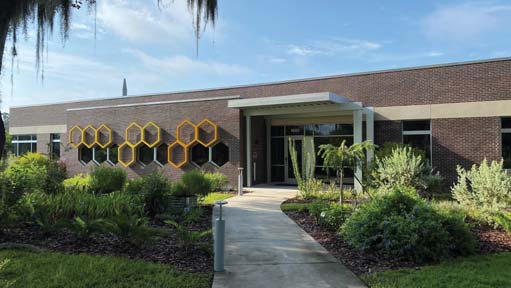
 “Jamie has received many state, regional and national awards for his work with honey bees. These include the National and Southern Region Excellence in Extension Awards (American Association for Public Land Grant Universities), Roger Hoopingarner Award (American Beekeeping Federation), Roger E. Morse Award for Teaching/Extension (Eastern Apicultural Society), Ed and Elaine Holcombe Distinguished Speaker Award (Eastern Apicultural Society), Research Foundation Professor (University of Florida), Superior Accomplishment Award (University of Florida), Outstanding Specialist (Florida Association of Agricultural Agents), and Entomologist of the Year (Florida Entomological Society).”
“Jamie has received many state, regional and national awards for his work with honey bees. These include the National and Southern Region Excellence in Extension Awards (American Association for Public Land Grant Universities), Roger Hoopingarner Award (American Beekeeping Federation), Roger E. Morse Award for Teaching/Extension (Eastern Apicultural Society), Ed and Elaine Holcombe Distinguished Speaker Award (Eastern Apicultural Society), Research Foundation Professor (University of Florida), Superior Accomplishment Award (University of Florida), Outstanding Specialist (Florida Association of Agricultural Agents), and Entomologist of the Year (Florida Entomological Society).”
In this address, we get an idea of Jamie’s essence: “I have a recurring dream. In that dream, I am back in high school, usually involved in some sort of sport. I dream about not trying very hard in that sport, realizing that my time in school is near completion, and having no opportunity to do better. I wake up a bit ashamed that I did not try harder when I had the chance.
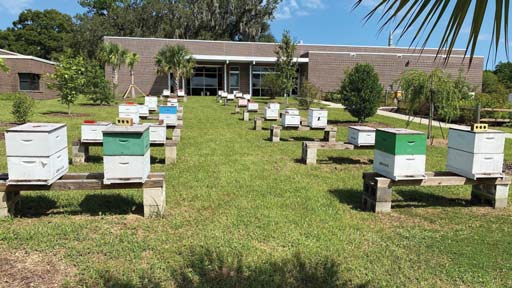
“I do not usually put much stock into dreams, but I do know why I have this dream. I played football my senior year in high school. In practice, we had a drill in which our coach ranked us from fastest on the team to slowest on the team. He then divided us into groups of three and made us race one another the entire length of the 100-yard field. If the designated fastest person in the group did not win, and the second-fastest come in second, etc., he made us all run the drill again.
“Unfortunately, rather than pushing to run faster, my teammates and I ensured we finished in the order in which we were expected to finish so that we would not have to run the drill again. As you might guess, our team was not very good.
“Exceptional individuals do not cut corners. They embrace opportunities for self-improvement.” https://tinyurl.com/xhjf8pm
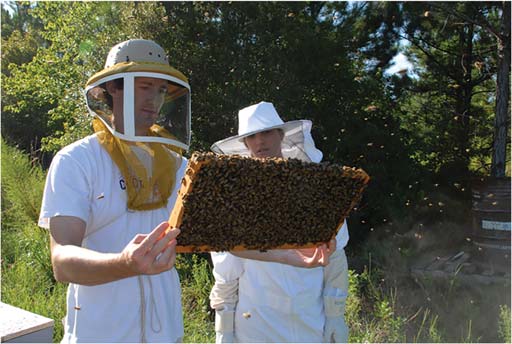
]]>